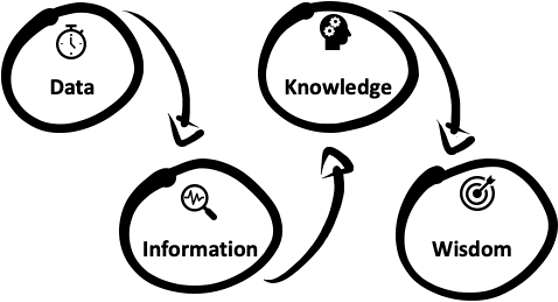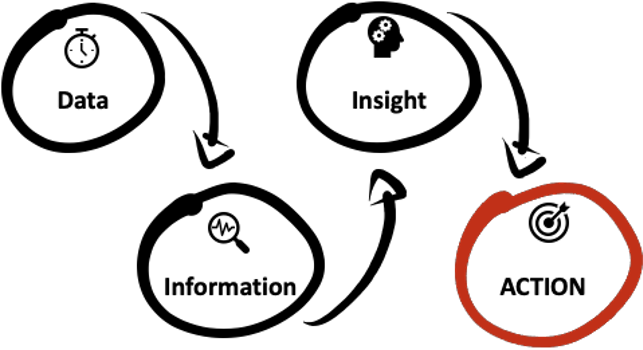Only ACTIONS drive results!
Our clients are so relentlessly targeted by “analytics” software vendors one would think that they have managed their businesses blindly for the last few decades. Granted, the nature of business analysis is changing with the explosion of data, advanced AI techniques, and new business models. But the questions remain the same: How do we run our business better? And if we invest in data and analysis capabilities how exactly will they help us achieve better results?
Traditionally, we have been conditioned to think about analytics in the following one-way flow:
- We organize data into structured information (“data warehouses”, ODS, etc..); out of which…
- We generate reports that create knowledge; this knowledge in turn…
- Allows us to understand what is really happening with our business (we create wisdom)

Insights to ACTIONS!
But wisdom is not enough. We have to do something with the wisdom that we have gained, which can only be achieved by turning the wisdom into specific INSIGHTS, and each insight into a specific ACTION.
Actions come in many forms: customer targeting, cross-sell programs, collection efforts, development of new products, segmented customer on-boarding, pricing changes, risk profiling, entering new markets – and often several actions such can be combined for the best result. The problem is in picking the right set of actions for each customer – at the time the actions are most valuable. Only ACTIONS drive results!
Creating effective Actions is difficult and expensive
As the world around us changes rapidly, our ability to turn petabytes of data into wisdom and then quickly into actions across many functions simultaneously (sales, marketing, finance, manufacturing etc..) becomes more and more complex. In a typical business today there are thousands of insights that can simultaneously be acted upon.
For most businesses, figuring out which are the right actions to take, when to take them, and actually taking the action in a timely manner is beyond human capabilities.
After the first few insights, we run into problems. The first is a problem of a scale that cannot be solved by throwing more wisdom generating humans at the problem. The people who can generate true wisdom are rare and expensive and maintaining a stable of high-level analysts will quickly become too expensive for most organizations. Additionally, there are often several other functions in the train – creating an ever-escalating expense line.
The second problem is a problem of timing as for the vast majority of institutions, connecting an insight to an effective action takes weeks or months of back and forth between IT, data science, product management, and marketing teams. This creates a large analytics lag and by the time each insight is ready to drive a profitable action, the market has often moved on and the opportunity is lost.
Activating Insights Automatically
To make the right choices, we need to adopt a different paradigm: “automatic generation and activation of insights” needs to become an integral part of the business analytics toolset.

Automating the activation process using both regular process automation and available AI techniques is critical. Through automation, we can reduce human expenditures and all but eliminate the analytic lag in most systems. Properly constructed, an automated process will generate new insights with each data load and turn them into an ACTION that can be executed the next minute, hour or day.
More importantly, a properly constructed analytics platform can automatically learn from the results of each action, and based on results improve the quality of the insight that generated the action with each iteration.
How does this really work?
While the mechanics are straightforward, the real challenge at this level is gaining a deep understanding of the realities of the products, channels, and markets that the action is being taken in. In our experience, developing a truly self-learning system can only be solved by integrating deep knowledge of the industry at hand – and building that knowledge into the system itself.
The key implication here is that “industry neutral” approaches to this problem won’t work as they invariably focus on automation of generic processes like lead routing while leaving the complex development of metrics and models to each institution to figure out.
RedPort’s Solutions
At RedPort we have been using our SmartPlatform technology to automate actions for almost a decade. To see how this works in banking take a look at our SmartBanker product.

Automation of actions can work for any industry: By starting with clear business objectives – collecting the right data – and using that data to automatically drive insights and actions – most businesses can turn their investment in standard analysis into a self-learning BUSINESS ACTIVATION capability in a matter of months.